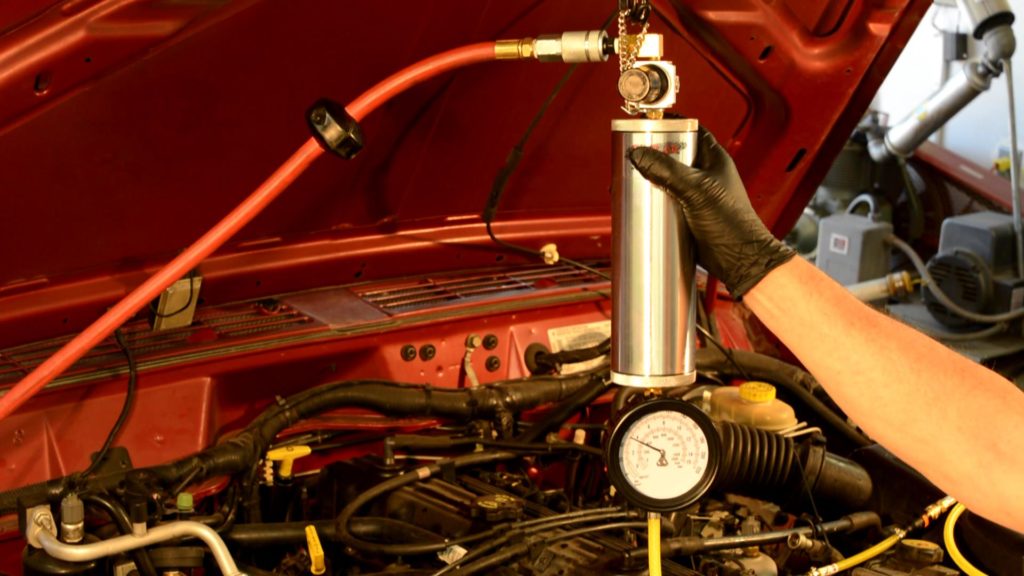How-to: 4.0L Jeep® Engine Diagnostics and Major Ignition and Fuel Injector Service…
At 186,000 miles, our Jeep Cherokee 4.0L engine was due for mechanical diagnostics and a tune-up. This how-to covers our tests of the engine’s mechanical condition followed by performing a complete ignition tune-up and fuel injector cleaning. We upgraded ignition components during the tune-up work.

Engine tuning always begins with evaluating the engine’s mechanical condition. Before “tuning” an engine, make certain that compression, manifold vacuum, valve timing (chain/sprocket wear on a 4.0L engine) and oil pressure are okay. Eliminate engine mechanical trouble before performing ignition service or fuel injector work.
A compression check was once a part of every engine tune-up. This test can now be done with a traditional compression gauge or a lab oscilloscope. Using an amperage clamp, the starter motor draw during cranking can indicate the “relative” compression of each cylinder. If a cylinder is suspected of not pulling its load, low compression can be pinpointed with a compression gauge then a cylinder leakdown test or in-cylinder pressure transducer with automotive lab oscilloscope.

If the engine meets the basic mechanical standards illustrated in the video, with no more compression deviation than 10% between the highest and lowest cylinders, an ignition and fuel system tune-up can make a difference. Fuel economy and performance depend upon proper tune. Your choice of tune-up components can improve the engine tune and prolong the intervals between major tune-up work.

The ignition service video covers a complete engine tune-up, including upgrades like the Taylor ThunderVolt® 8.2mm ignition cables made in the U.S.A. Taylor has built quality ignition components since 1923 and is now part of the Pertronix® Products family. Follow the steps for spark plug, distributor cap, rotor and spark cable replacement.
Fuel Injector Cleaning
4WD Mechanix Magazine has stressed the importance of clean fuel injectors. The magazine has demonstrated the S.U.R.&R. FIC 903 upper engine cleaning tool plus the FIC 203 direct fuel rail injector cleaning kit. These tools are highly effective with Sea Foam Motor Treatment as the cleaning agent. When using the FIC 203 for a gasoline engine, Sea Foam is mixed 50/50 with gasoline. Diesel engines will run on pure Sea Foam through the FIC 203 canister. (Never run gasoline in a diesel engine—for any purpose!) The FIC 903 is for top engine cleaning on gasoline engines only. The FIC 903 uses pure Sea Foam introduced through the intake manifold, typically via the brake booster hose.

To better demonstrate fuel injector performance and how to clean injectors off the engine, we invested in an AUTOOL® CT200 Fuel Injector Cleaning and Test Machine. The ‘Part 2’ video is devoted to removal, cleaning and testing of the 1999 XJ Cherokee engine’s fuel injectors. We test for spray patterns, fuel flow volume and performance from an idle to 7,500 rpm. Both ultrasonic and reverse flow cleaning are possible.

These OEM injectors have been performing for 186,000 miles, and the cleaning results are impressive. The injectors are functioning as new from the ultrasonic cleaning process, and highway fuel mileage has gone up 2-3 miles per gallon since this injector service and major ignition tune-up. Throttle response has dramatically improved.

For our shop/studio, the AUTOOL® CT200 was a wise investment. Well built and affordable, the machine will pay for itself quickly by eliminating sublet labor costs for injector cleaning. We can quickly test and clean injectors in house. Testing flow rate and comparing volume on new or serviceable injectors enables matching the set of injectors for best air/fuel ratio balance and fuel trims. Any independent shop or serious DIY tuner should consider the value of this machine.

We also used a bore camera to look for carbon build-up in the lowest and highest compression cylinders. Both piston crowns showed the significant cleaning power of the S.U.R.&R. FIC 203 and FIC 903 equipment and Sea Foam®. The bore camera shows how piston carbon has been dramatically reduced and could be reduced further by more use of these top engine cleaning tools.
The low cylinder still has some carbon around the exhaust valve, which could be dropping compression slightly if that valve is not sealing perfectly. By any standard, 145 PSI at the low cylinder is fully acceptable, but another round with the FIC903 and Sea Foam might bump compression to the 150-155 range to match other cylinders. The high cylinder is at 160 PSI and could afford to shed some more carbon build-up. Rings and valves at that cylinder are sealing well.
Overall, the XJ Cherokee remains on course for at least another 75,000 miles of reliable service. The bore camera findings suggest the option of an in-chassis piston-and-rings changeout, using a professional grade hone like the Lisle 15000 series. A cylinder head sublet for valve work would be timely.
A stroker crankshaft with stock bore yields 4.5L instead of 4.6L. If the engine requires boring rather than an in-chassis overhaul with stock size pistons, 0.030″ oversize would be likely. With the engine out of the chassis, a stroker crankshaft would be a must, the end result being 4.6L. Injectors would be upgraded for more flow and four holes.
For now, this tune-up and fuel injector refresh on the stock 4.0L will do the job!

